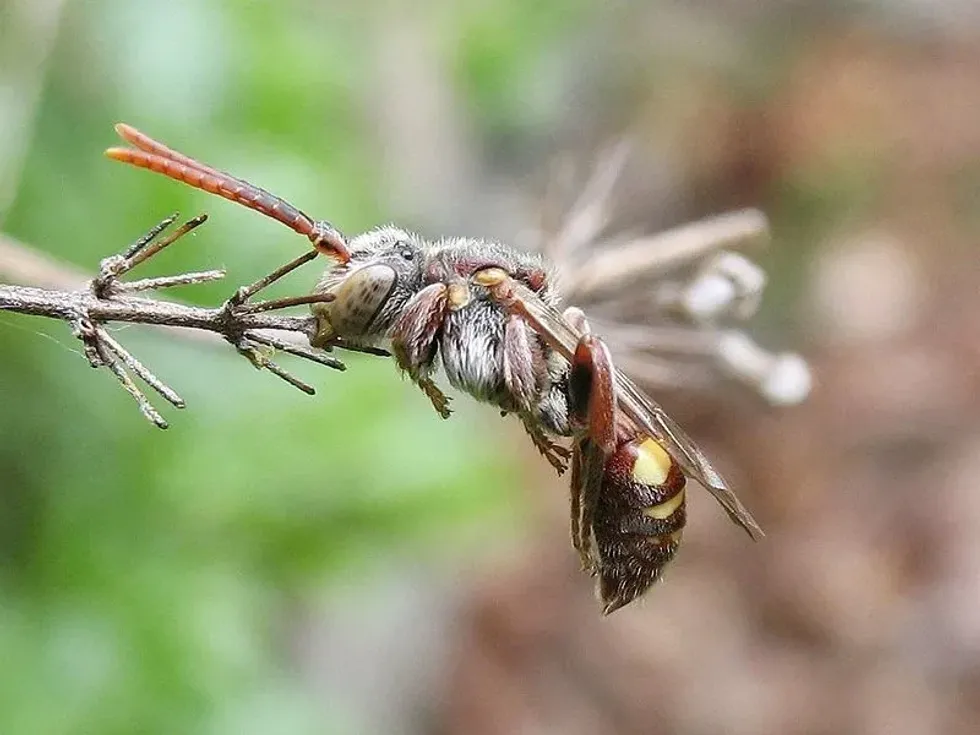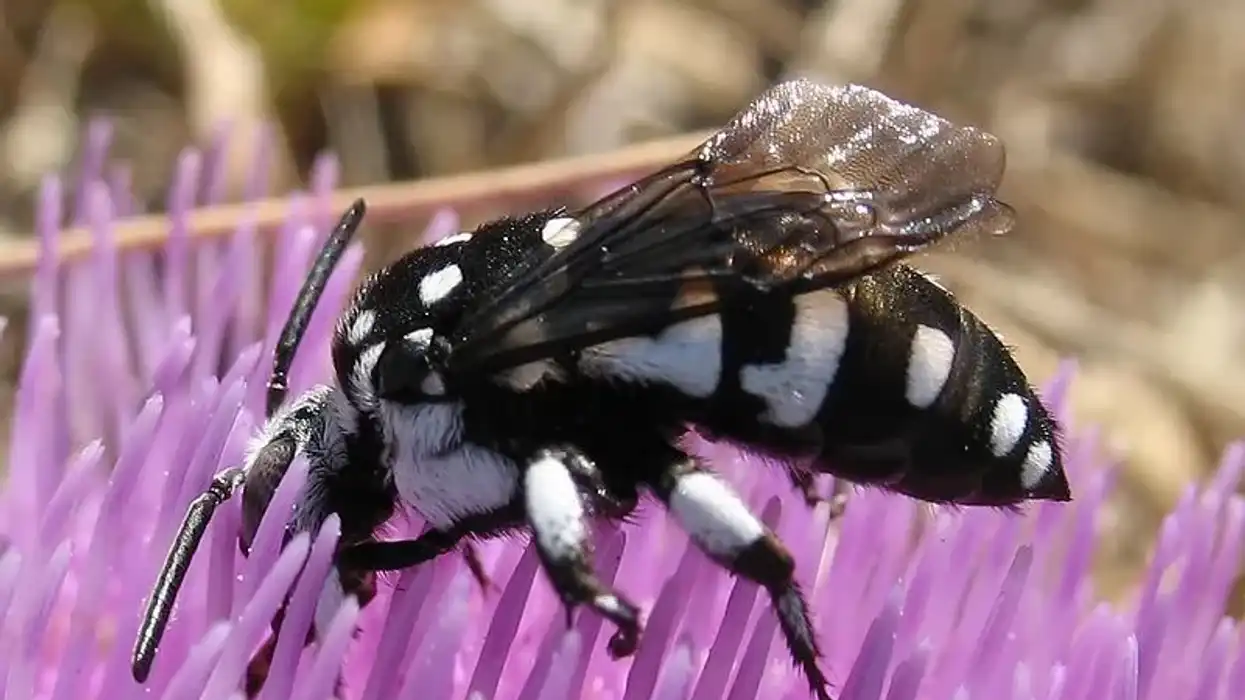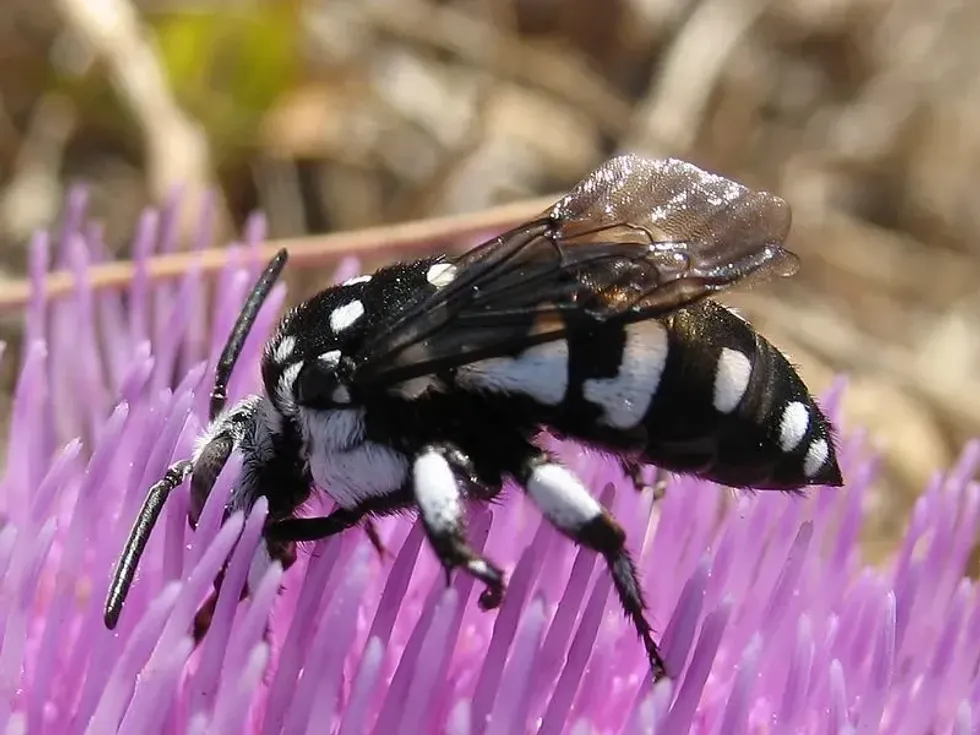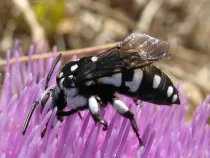Fun Parasitic Bees Facts For Kids

Content
- What type of animal are parasitic bees?
- What class of animals do parasitic bees belong to?
- How many parasitic bees are there in the world?
- Where do parasitic bees live?
- What is a parasitic bee's habitat?
- Who do parasitic bees live with?
- How long do parasitic bees live?
- How do they reproduce?
- What is their conservation status?
- What do parasitic bees look like?
- How cute are they?
- How do they communicate?
- How big are parasitic bees?
- How fast can parasitic bees move?
- How much do parasitic bees weigh?
- What are their male and female names of the species?
- What would you call a baby parasitic bee?
- What do they eat?
- Are they harmful?
- Would they make a good pet?
- Did you know...
- Different types of parasitic bees
- Parasitic bees and other creatures
The parasitic or cuckoo bee is a type of sweat bee that gets its name because of its parasitic nature. The females of this parasite species enter into the nest of another species and replace the resident’s eggs with their own eggs.
As they leave, they cover their tracks by pushing loose soil over the opening of the nesting.
The unwitting host bees and their colonies are duped easily and continue feeding the young brood. This way, the parasitic fee parents are released from any responsibility of providing for their young brood.
Parasitic bees can vary in color. Some of them are black and yellow while others are black and red.
Some of them have color bands while others don’t. However, none of them have pollen baskets attached to their legs as they don’t have to collect grains for their offspring in the nest.
Also, they are not fuzzy like other bees and look like wasps. The adult parasitic bee area is active in summer and spring and can be seen in gardens, meadows, parks, and other similar habitats. Since they are good pollinators, they are considered beneficial on the farm or in the garden.
Please note that these should not be confused with the Varroa destructor, external parasitic mites. They attack Apis cerana and Apis mellifera, two non-parasitic honey bee colony and feed on them.
You may also want to check out bumblebee facts and mud dauber wasp facts from Kidadl.
Parasitic Bees Interesting Facts
What type of animal are parasitic bees?
The term parasitic bee is used for a wide range of bee lineages with brood parasitism behavior where they lay their eggs in other bees’ nests. This is reminiscent of the cuckoo bird’s behavior.
The name is best applied to the Nomadinae apid subfamily but is common for bumblebees Bombus subgenus Psithyrus found in Europe. They attack the non-parasitic honey bee colony and feed on them. Parasitic bees use the cell chambers and nests of their host bees to lay their larvae.
What class of animals do parasitic bees belong to?
The parasitic, or cuckoo, bees belong to the Insecta class. The queens of this parasite species infiltrate the nests of other species.
However, they don’t just dump their eggs like cuckoo birds. Since their host bee is eusocial, they have to trick the colonies and not just the parents.
They are also considered to be social parasites as they exploit the entire colony and trick the host bee workers into taking care of the cuckoo bee's egg. The adult female cuckoo might even kill and eat the host larvae from the egg.
How many parasitic bees are there in the world?
No data is available on the parasitic bee's population.
Where do parasitic bees live?
Parasitic bees can be found in a wide range of habitats, including woodlands, heaths, gardens, and other urban areas. Basically, wherever the host species lives, there is a chance that you will see a cuckoo bee.
They can be easily found across the UK. However, some species are rarer. Parasitic bees use the cell chambers and nests of their host bees to lay their larvae.
What is a parasitic bee's habitat?
The habitat of a parasitic bee or a cuckoo bee is an open area like gardens, parks, woodlands, heaths, etc. They attack non-parasitic honey bee colonies and feed on them. Parasitic bees live a solitary life, not in a colony like the honey bee. The adult female cuckoo might even kill and eat the host larvae from the egg.
Who do parasitic bees live with?
Parasitic bees live a solitary life, not in a colony like the honey bee. Parasitic bees use the cell chambers and nests of their host bees to lay their larvae.
How long do parasitic bees live?
No information is available on their lifespan.
How do they reproduce?
The queens of the cuckoo bees have a solitary phase where they emerge alone from hibernation during early spring, find a nest, and lay down a batch of worker bees. These workers emerge in spring and take over the foraging and nursing for subsequent worker generations.
As the summer ends, the colonies start producing reproductive females and males through eggs.
The solitaire gynes leave their nest, mate, and start hibernating from early Autumn. The cuckoo bee emerges in spring and usurps the host’s nests when the first worker bees’ batch is produced.
Since they only produce eggs with reproductive females and males from early to mid-summer, their life is shorter. Just like their host, the solitary gynes leave the nest, mate, and start hibernating.
The term parasitic bee is used for a wide range of bee lineages that have brood parasitism behavior of the colony where they lay their eggs in other bees’ colony nests.
The adult female cuckoo might even kill and eat the host larvae from the egg. Parasitic bees use the cell chambers and nests of their host bees to lay their larvae.
What is their conservation status?
The conservation status of parasitic bees can vary according to species.
Parasitic Bees Fun Facts
What do parasitic bees look like?

Recognizing the females of the parasitic or cuckoo bee species is very easy as they don’t have the scopa, pollen-collecting structures, since they don’t have to build their own nests. They can also be identified by their heavily sculptured and abnormally thick exoskeleton, reduced body hair, and saber-like mandibles.
However, this is not true for all the different species of parasitic bees. There are other changes that are much less visible.
In fact, differentiating them from their hosts isn’t always easy as they are similar in appearance. Here are a few things to look out for: dark-tinted wings, lack of pollen baskets on its legs, less dense hair with a shiny abdomen, and thorax showing through.
How cute are they?
Even though they appear little and fuzzy, most people are afraid of parasitic bees and don’t find them cute.
How do they communicate?
Parasitic bee communication can vary according to genus but mostly relies on pheromones.
How big are parasitic bees?
An adult parasitic bee can be somewhere between 0.15 in - 0.59 in (4 mm - 15 mm) in length.
How fast can parasitic bees move?
A parasitic, or cuckoo, bee can reach a speed of 34 mph (54 kph).
How much do parasitic bees weigh?
An adult parasitic bee can weigh somewhere between 0.005 - 0.007 oz (150 - 200 mg).
What are their male and female names of the species?
The male parasitic bee is called a drone, whereas the female parasitic bee is called a queen.
What would you call a baby parasitic bee?
A baby parasitic bee is called a larva. The adult female cuckoo might even kill and eat the host larvae from the egg.
What do they eat?
Cuckoo or parasitic bees feed on flowers to drink their nectar. The females have to eat pollen to develop their ovaries.
In the case of cleptoparasitic bees, the hard work ends there. They don’t have to take pollen and nectar back to their nest as it is left to the host workers.
They eat existing pollen balls that are left by the host or the new pollen stocks that the host workers bring inside the nest. The adult female cuckoo might even kill and eat the host larvae from the egg.
Are they harmful?
Parasitic bees are more harmful to the solitary species than they are to the social bees. However, this doesn’t mean that they don’t cause casualties. For humans, they are just as dangerous as a normal bee. There is not much information on how to protect honey bees from parasitic flies like the cuckoo bee.
Would they make a good pet?
Yes, there have been a lot of cases where people have made bees into good pets without getting a sting. However, it is near impossible to have parasitic bees as pets.
Did you know...
There are a lot of cuckoo bees found in North Merseyside, Manchester, and Lancashire. Here are a few of them.
Bombus Vestalis or vestal cuckoo bee, even though this is a traditionally southern species, in the past few years, it has made its way furthers north and isn’t uncommon in the region.
The female host of choice is the buff-tailed bumblebee that can be easily found feeding on dandelions or sallow catkins or investigating the ground for nests. The male vestal cuckoo bees feed on knapweeds, brambles, thistles, and garden plants such as lavender.
Bombus Rupestris or red-tailed cuckoo bee. The red-tailed cuckoo bee uses the red-tailed bumblebee as its host and is, in fact, closely related to it. They are black in color and have a red tail.
The females of this species are known to be impressive insects. In fact, they are the largest cuckoo bee that has the biggest wingspan of any bee found in the UK.
You can see them during late spring, patrolling the grassy banks deliberately to look for host nests. They can feed on several flowers, including bugle, comfrey, and dandelions. The new summer females visit knapweeds, teasel, and spear thistle.
Bombus Sylvestris or forest cuckoo bee. As the name suggests, this species of cuckoo bee can be commonly found in woodlands. Its choice of host is the early bumblebee. The females have a characteristic stance where they curl up the tip of their abdomen underneath themselves.
The female of the species appears in April, before the second brood in June. The second-generation females feed on early autumn flowers such as ivy and devil’s bit scabious. The male species have a special quirk where they produce a mousy scent.
Bombus Bohemicus or gypsy cuckoo bee. The Gypsy cuckoo bee is quite similar to the white-tailed bumblebee, its host. They have a white tail and a yellow collar on their thorax.
There is also a small yellow patch on both sides of their abdomen, right above their tail. Males might also have another yellow band at the back of their thorax.
They live in a multitude of habitats, feed on a wide range of flowers, and aren’t too fussy. The females of the species emerge from their hibernation in April or May. The new females and males emerge in July and August.
Bombus Capestris or field cuckoo bee. When it comes to habitat, the field cuckoo bee is another generalist.
The field cuckoo bee is yellow-colored, has a yellow stripe on the top as well as the bottom of its thorax, and yellow patches on both sides of the abdomen. The color is more extensive in male bee parasites who have their entire abdomen look yellow.
These bee parasites of the common carder bee can be found in a wide range of settings and feed on several flowers.
The female of the parasite species emerges from their hibernation around late April. The new females and males emerge somewhere between July to September.
Different types of parasitic bees
Cuckoo or parasitic bees are the ones that don’t make nests for themselves or forage for food. Instead, they enter the nests of other species and food supplies and even replace the host’s larva with their own in the host's brood cells.
They are of two types: Cleptoparasitic bees, wherein the adult bees invade the solitary bees’ nests, lay their larva in unsealed, but finished brood cells made by the queen bee for her own larvae, and close the chambers.
Then, the young cuckoo bees feed upon the food stored by the host female in the chamber for her own offspring.
The young larvae or eggs of the host queen are killed by the parasitic female or her larvae. The cuckoo bee’s larvae then are able to claim the nest and cells of the solitary queen bee.
The other type are social parasites, where adult cuckoo bees are the ones that kill the resident queen, use the host cells for laying their larvae, and force the entire colonies to raise the offspring bees.
The female cuckoo solitary bees don’t have special features such as pollen brushes or pollen baskets as they don’t have to forage for food to feed their young.
Parasitic bees and other creatures
Parasitic bees use the cell chambers and nests of their host bees to lay their larvae. Then, they kill the larvae of the host bee and even cover their tracks.
Parasitic bees are also known to use a virus that can attack the brain of a ladybug and force them to become babysitters of the bee's offspring. The only common trait between ladybugs or ladybirds, honey bees, and parasitic wasps is that they are insects with wings.
Here at Kidadl, we have carefully created lots of interesting family-friendly animal facts for everyone to discover! Learn more about some other arthropods from our woodlouse facts or atlas beetle facts pages.
You can even occupy yourself at home by coloring in one of our free printable Parasitic Bees coloring pages.
We Want Your Photos!
More for You
Bachelor of Science specializing in Mass Communication.

Adekunle Olanrewaju JasonBachelor of Science specializing in Mass Communication.
Bachelor of Arts specializing in English Literature, Masters of Art specializing in English and Communication Skills

Sonali RawatBachelor of Arts specializing in English Literature, Masters of Art specializing in English and Communication Skills
Sonali has a Bachelor's degree in English literature from Guru Gobind Singh Indraprastha University and is currently pursuing a Master's in English and Communication from Christ University. With considerable experience in writing about lifestyle topics, including travel and health, she has a passion for Japanese culture, especially fashion, and anime, and has written on the subject before. Sonali has event managed a creative-writing festival and coordinated a student magazine at her university. Her favorite authors are Toni Morrison and Anita Desai.
Disclaimer
1) Kidadl is independent and to make our service free to you the reader we are supported by advertising. We hope you love our recommendations for products and services! What we suggest is selected independently by the Kidadl team. If you purchase using the Buy Now button we may earn a small commission. This does not influence our choices. Prices are correct and items are available at the time the article was published but we cannot guarantee that on the time of reading. Please note that Kidadl is a participant in the Amazon Services LLC Associates Program, an affiliate advertising program designed to provide a means for sites to earn advertising fees by advertising and linking to Amazon. We also link to other websites, but are not responsible for their content.
2) At Kidadl, we strive to recommend the very best activities and events. We will always aim to give you accurate information at the date of publication - however, information does change, so it’s important you do your own research, double-check and make the decision that is right for your family. We recognise that not all activities and ideas are appropriate for all children and families or in all circumstances. Our recommended activities are based on age but these are a guide. We recommend that these ideas are used as inspiration, that ideas are undertaken with appropriate adult supervision, and that each adult uses their own discretion and knowledge of their children to consider the safety and suitability. Kidadl cannot accept liability for the execution of these ideas, and parental supervision is advised at all times, as safety is paramount. Anyone using the information provided by Kidadl does so at their own risk and we can not accept liability if things go wrong.
3) Because we are an educational resource, we have quotes and facts about a range of historical and modern figures. We do not endorse the actions of or rhetoric of all the people included in these collections, but we think they are important for growing minds to learn about under the guidance of parents or guardians.







